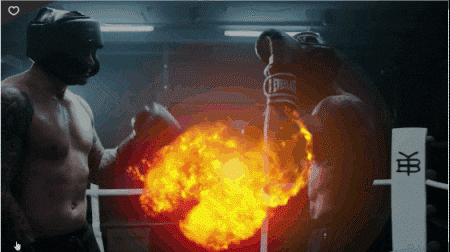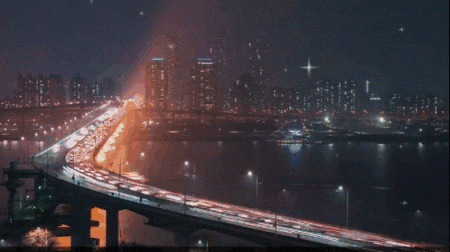- Home
- DIY Special Effects
- Tips for Making a Visual Impact With Liquid Text Animation
Transcript
What is going on, guys? Welcome to the third tutorial in my course series! In this tutorial, I will show you guys how to create this cool liquid text animation inside of Filmora 13. This animation is straightforward, so let's jump into Filmora and start.
Here, I use 1920 x 1080 resolution with 60 FPS. You can use any resolution you like here. First, we need to add a background. So, I went to the stock media and picked this black color as my background. I will use black because we are going to use glow effects.
We need to add text, so go to the text and add the default title to the timeline. Go to the text settings and customize it as you like. Here, I type liquid, use Gotham Ultra italic font style, and increase the text scale slightly like this.
After that, we need to create a stroke text layer, so I take a copy of this text layer and paste it right here. We need to change this to a stroke text. Go to the advanced settings, turn off the fill, and enable the outline. I change the outline color to white and the outline thickness to 2. Click apply! Now, we have both our text layers.
Now, let's add animation to our stroke text layer. Go to the animation, and I will add this typewriter animation to this. Also, I change the duration to something 1 second. Now, we have this kind of Animation. I like to add zoom-out animation. I go to the beginning of this layer and the video section.
Now, we have to create our velocity part. First, I select my first beat and select the layer, then split it right here. Go forward and select the range you want to speed up. Select here and split it like this. I selected this part and added a "Flash in" graph to it. Go to the graph, select this point right here, and remove it. Drag this layer to here. After that, go to the second beat and split the layer like we had done before. Select the range you want to speed up and split the layer like this.
Now, we need to change these layers to compound clips. First, I select this stroke text layer and press alt+ G to create a compound clip. I named it the stroke text layer and hit okay. I chose these two layers and changed them to a compound clip. I named it normal text and hit okay. After creating the compound clips, bring these layers to the upper layer like this. After that, I hide these layers for now.
We need to create our liquid waves. First, we need to add a color layer. Go to the stock media. You can pick any solid color or gradient color you like. I selected this blue color and added it to the timeline. We need to add slide-up animation, so I chose here on the timeline, brought this layer down, and created a keyframe. Go a few seconds forward, like 4 seconds, and bring this layer up like this.
Now, we have this slide-up animation. I like to add two more layers. I took a copy of this layer and pasted it two times. We can replace the color of these layers. Pick another color you like. I select this light blue color and drag it on top of this layer. Hold the ALT key on the keyboard and drop it like this. You can see it replaced our layer color. Next, I need to do the same thing for my other layers. I do it like this. You can see we don't need to recreate our animations.
After that, we need to change these layers to a compound clip. First, I select this layer and press alt+ G to create a compound clip. I named it Wave 1 and hit okay. I do the same thing for my other color layers.
After creating the compound clip, we need to add a wave effect to this. Go to the effects tab, select Boris FX, and select Warp. Select the BCC wave effect, and I add it to my wave one layer. It gives this kind of look, but we need to adjust some settings to this effect. Go to the effect settings and first select the height.
You can adjust the wave height using this setting. I change it to something 300. Go to the wave width, and I will change it to 260. I change the speed value to something like 1.5, go to the wave angle, and change the angle to 80. Now, we have this kind of wave animation.
We need to add this wave effect to our other wave layers. You can do it by right-clicking on this layer, selecting effect, then selecting copy effect. After that, I chose my Wave 2 layer and right-clicked select effect. Select paste effect. Now, we have the same wave effect. I do the same thing for my wave three layers. After that, go five frames forward and drag these layers like this. Now, our wave animation looks like this.
Now our main part is complete. We need to create our beginning part. I use this kind of low-quality look effect for this. Let's see how to create that quality. First, go to the effects tab, select new blue FX, select filters, then select this frame rate effect and add it to this layer like this.
Here, you can see an empty look in this area. We can fix that by adjusting the wave layer position, but first, we need to change the wave scale. I select this layer, go to the scale, and then click the lock button. After that, I increase the X scale to something 140, then do the same for my other wave layers like this. After that, we can adjust the layer's position like this. Now, we have completed our liquid wave animation.
Now, we need to put these waves inside our text. First, I unhide my normal text layer. After that, we must blend this layer to be visible in our wave animation inside our text. Go to compositing and change the blend mode to darken. Now, it looks like this. After that, we can add our stroke text layer to this, so I unhide my stroke text layer.
I want to add Fade-out animation to this stroke text, so I selected it here and created a keyframe on opacity. Go a few seconds forward and change the opacity to zero like this. Open the key frame panel, select this last keyframe, and add a curved preset to this. Now, our liquid text animation looks like this.
Finally, we need to add our glow effect to this. First, I drag my stroke text layer to the upper layer. We need to add an adjustment layer to add our effect. I add it like this. Go to the effect tab, Select Plus light in the Boris FX, then select BCC plus Rays effect and add it to this adjustment layer. This effect gives our animation an excellent, glowy ray look.
Let's animate our glow effect. Go to the effect settings and select Rays. You can adjust the brightness you like. I change it to something like 90. We need to add a fade-out look to our glow effect. I selected it here and created a keyframe on brightness. Go to the end of the animation, and I will change the brightness to something like 13 or something 12. Now, our liquid text animation is complete. Here's the result.
That's how we can make awesome liquid text animation inside Filmora 13. It's straightforward to create, and you can download the complete project file through the link in the description. Also, if you need to learn more about Filmora tutorials, you can check my Filmora tutorial playlist or visit the Filmora Creator Hub to access more awesome tutorials. You can follow the links below to access the Filmora Creator Hub. That's it, guys.
Thanks for watching this tutorial! I hope you enjoy this. Also, please leave a like this video and be sure to subscribe to my channel and leave a comment about this video. What tutorial would you like next? Let's meet up for the next video. Take care and peace!
How to Create a Stunning Liquid Text Animation?
What you need to prepare:
- A computer (Windows or macOS)
- Your video materials.
- Filmora video editor
Set the Project Resolution and Background
Set the project resolution to 1920 x 1080 with a 60 FPS frame rate. You should choose any resolution that suits your preference. Add a black background from the stock media library. This color will complement the glow effects that we will discuss later.

Add and Customize Text Layers
Add a default title text layer to the timeline. Open the text settings and customize the text as desired. You can type any text you want. For example, type "liquid" using the Gotham Ultra italic font style and increase the text scale.

Create a Stroke Text Layer
You should duplicate the text layer and turn off the fill. Ensure you enable the outline. You will get all these options in the advanced settings. Change the outline color to white and set the outline thickness to 2. Click apply to create a stroke text layer.

Animate the Stroke Text Layer
Add a typewriter animation to the stroke text layer and adjust the duration to around 1 second.

You can create a zoom-out animation. Increase the scale to 200 at the beginning. Create a keyframe and reduce the scale back to 100 a few seconds later. You can add a curve preset to the keyframes by right-clicking. It will create a smooth animation.

Create Compound Clips
Convert the stroke text layer into a compound clip. You can do it by pressing alt + G. Follow the same to change two text layers (normal and stroke text) into compound clips. Bring the compound clips to the upper layers and hide them temporarily.

Create Liquid Wave Layers
Add a solid color layer and apply a slide-up animation by creating keyframes. You must move the layer from the bottom to the top over a few seconds. Duplicate the layer and replace the colors with different shades you prefer. Create compound clips for each wave layer.

Apply Wave Effects
You can add the BCC Wave effect. Go to the Boris FX and choose the Warp category for the first wave compound clip. Adjust the wave height, width, speed, and angle settings. It can help you achieve the desired wave animation. Copy and paste the effect onto the other wave compound clips. Finally, you can offset their positions slightly.

Adjust Wave Scale and Position
Increase the horizontal scale of the wave layers to around 140 and unlock the scale aspect ratio. Adjust the positions of the wave layers to fill any empty spaces in the animation.

Blend Text and Waves
Unhide the normal text compound clip and change its blend mode to darken. It will make the wave animation visible inside the text. Unhide the stroke text compound clip and add a fade-out animation. You can do it by creating opacity keyframes and applying a curve preset.

Add Glow Effect
Drag the stroke text compound clip to the top layer. Add an adjustment layer and apply the BCC Plus Rays effect from the Boris FX Plus Lights category. Adjust the brightness settings and animate the effect by creating brightness keyframes. You can start with a high value and decrease it towards the end.

Finalize the Animation
Review the final liquid text animation! You can make any necessary adjustments in the animation to achieve the desired result.

Crafting a liquid text animation is an art form that needs creativity. It can help you create visually striking animations that leave a lasting impression. You must explore and experiment with different styles, effects, and techniques. Many such tips are readily available at Filmora Creator Hub. Remember, practice and persistence are vital to mastering this effect.




